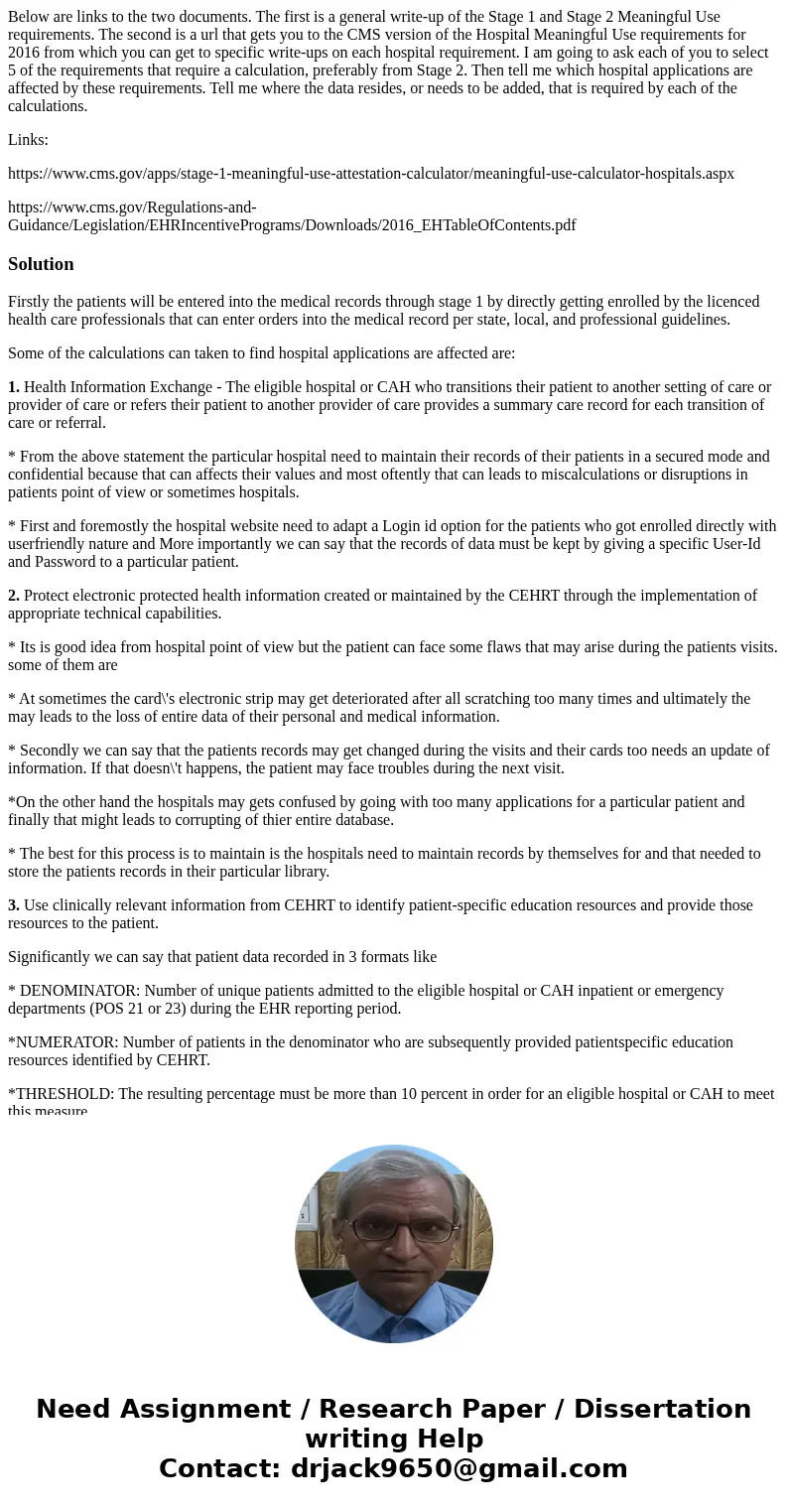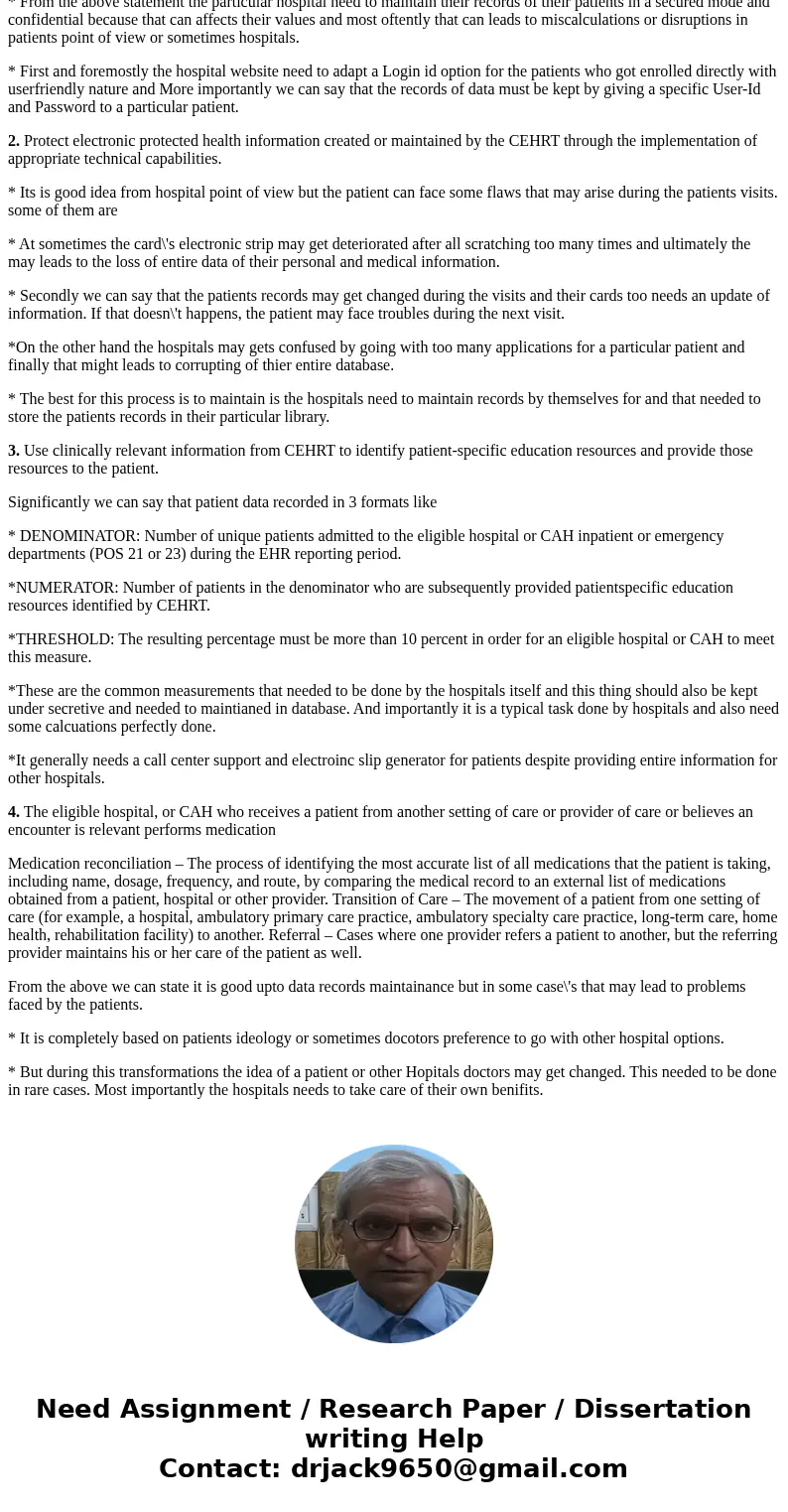Below are links to the two documents The first is a general
Below are links to the two documents. The first is a general write-up of the Stage 1 and Stage 2 Meaningful Use requirements. The second is a url that gets you to the CMS version of the Hospital Meaningful Use requirements for 2016 from which you can get to specific write-ups on each hospital requirement. I am going to ask each of you to select 5 of the requirements that require a calculation, preferably from Stage 2. Then tell me which hospital applications are affected by these requirements. Tell me where the data resides, or needs to be added, that is required by each of the calculations.
Links:
https://www.cms.gov/apps/stage-1-meaningful-use-attestation-calculator/meaningful-use-calculator-hospitals.aspx
https://www.cms.gov/Regulations-and-Guidance/Legislation/EHRIncentivePrograms/Downloads/2016_EHTableOfContents.pdf
Solution
Firstly the patients will be entered into the medical records through stage 1 by directly getting enrolled by the licenced health care professionals that can enter orders into the medical record per state, local, and professional guidelines.
Some of the calculations can taken to find hospital applications are affected are:
1. Health Information Exchange - The eligible hospital or CAH who transitions their patient to another setting of care or provider of care or refers their patient to another provider of care provides a summary care record for each transition of care or referral.
* From the above statement the particular hospital need to maintain their records of their patients in a secured mode and confidential because that can affects their values and most oftently that can leads to miscalculations or disruptions in patients point of view or sometimes hospitals.
* First and foremostly the hospital website need to adapt a Login id option for the patients who got enrolled directly with userfriendly nature and More importantly we can say that the records of data must be kept by giving a specific User-Id and Password to a particular patient.
2. Protect electronic protected health information created or maintained by the CEHRT through the implementation of appropriate technical capabilities.
* Its is good idea from hospital point of view but the patient can face some flaws that may arise during the patients visits. some of them are
* At sometimes the card\'s electronic strip may get deteriorated after all scratching too many times and ultimately the may leads to the loss of entire data of their personal and medical information.
* Secondly we can say that the patients records may get changed during the visits and their cards too needs an update of information. If that doesn\'t happens, the patient may face troubles during the next visit.
*On the other hand the hospitals may gets confused by going with too many applications for a particular patient and finally that might leads to corrupting of thier entire database.
* The best for this process is to maintain is the hospitals need to maintain records by themselves for and that needed to store the patients records in their particular library.
3. Use clinically relevant information from CEHRT to identify patient-specific education resources and provide those resources to the patient.
Significantly we can say that patient data recorded in 3 formats like
* DENOMINATOR: Number of unique patients admitted to the eligible hospital or CAH inpatient or emergency departments (POS 21 or 23) during the EHR reporting period.
*NUMERATOR: Number of patients in the denominator who are subsequently provided patientspecific education resources identified by CEHRT.
*THRESHOLD: The resulting percentage must be more than 10 percent in order for an eligible hospital or CAH to meet this measure.
*These are the common measurements that needed to be done by the hospitals itself and this thing should also be kept under secretive and needed to maintianed in database. And importantly it is a typical task done by hospitals and also need some calcuations perfectly done.
*It generally needs a call center support and electroinc slip generator for patients despite providing entire information for other hospitals.
4. The eligible hospital, or CAH who receives a patient from another setting of care or provider of care or believes an encounter is relevant performs medication
Medication reconciliation – The process of identifying the most accurate list of all medications that the patient is taking, including name, dosage, frequency, and route, by comparing the medical record to an external list of medications obtained from a patient, hospital or other provider. Transition of Care – The movement of a patient from one setting of care (for example, a hospital, ambulatory primary care practice, ambulatory specialty care practice, long-term care, home health, rehabilitation facility) to another. Referral – Cases where one provider refers a patient to another, but the referring provider maintains his or her care of the patient as well.
From the above we can state it is good upto data records maintainance but in some case\'s that may lead to problems faced by the patients.
* It is completely based on patients ideology or sometimes docotors preference to go with other hospital options.
* But during this transformations the idea of a patient or other Hopitals doctors may get changed. This needed to be done in rare cases. Most importantly the hospitals needs to take care of their own benifits.


 Homework Sourse
Homework Sourse